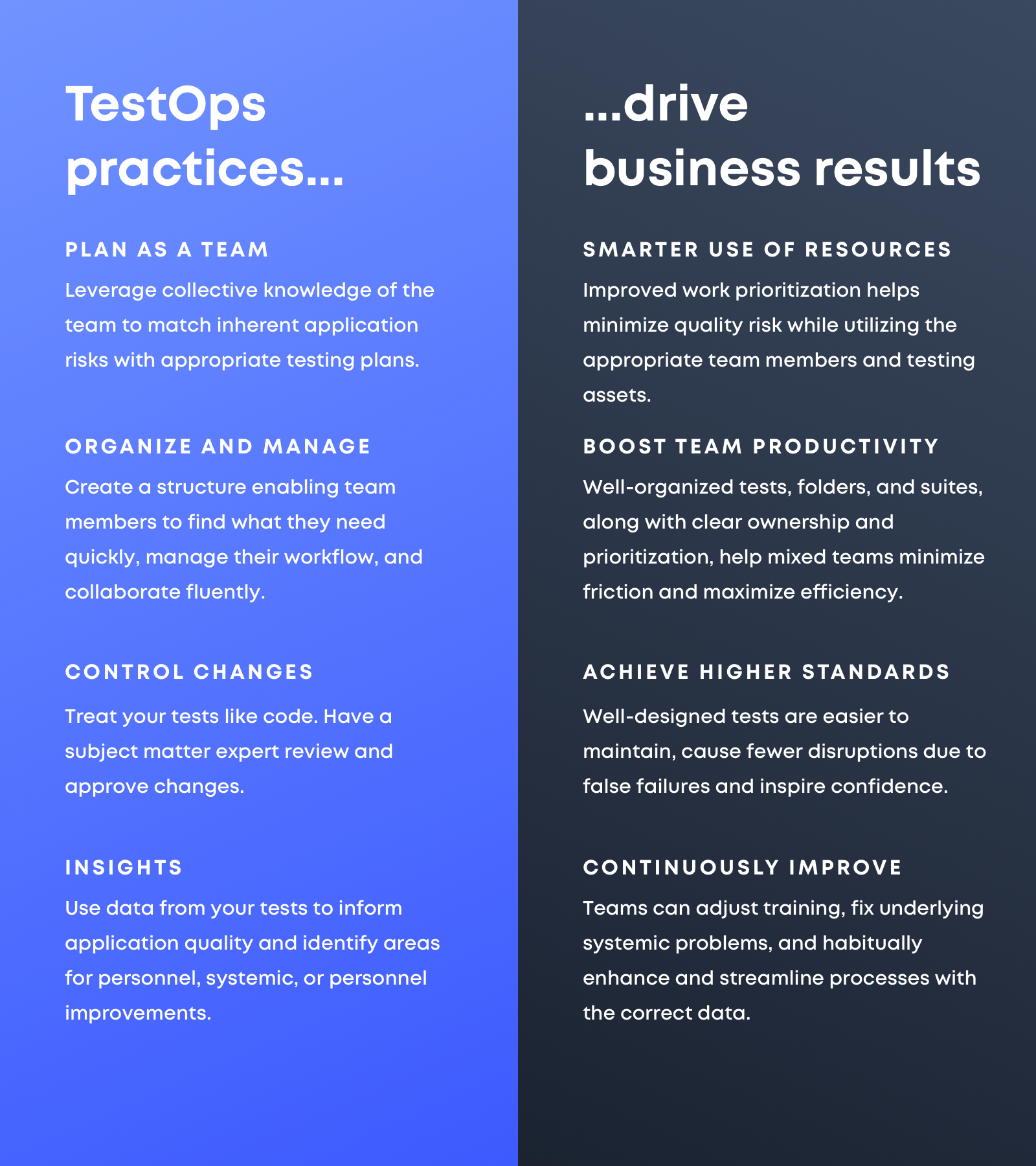Introduction
Two trends drive an increased need for end-to-end testing: growth in web applications and development modernization.
Web applications continue to grow in popularity for B2B and B2C use cases. As browsers have evolved, more of the application code has shifted to the front-end of applications.
At the same time, modern development methodologies demand faster iteration and releases. With shorter, more frequent cycles, the pace of innovation is too fast for manual regression testing.
Modern test automation practices replace slower methods while bringing more diverse testers, including developers, product owners, and automation engineers.
Scaling your tests, teams, and projects efficiently is both a significant challenge and an opportunity to lead.
This ebook will discuss tips and techniques for scaling testing operations (TestOps) more efficiently and effectively.
Why test automation? Why now?
The digital footprint quality teams have to manage is increasing each year. The growth is especially prevalent in web applications. Evolving JavaScript frameworks and platform and hosting services enable agile teams to release new functionalities in their web apps quickly. Rather than deprecate old features, developers can adapt them with new UX experiences.
Quality Assurance teams (whether separate or embedded) have a tough choice to make—add resources, take on more risk, or delay releases.
Test Automation has been the saving grace for many software organizations, allowing them to (somewhat) keep pace. However, the continued shift to faster development methodologies and the importance of a digital presence have highlighted vital gaps.
Relying on older test automation frameworks to code functional and UI tests simply takes too long. And the lack of stability in rapidly changing applications reduces the time teams can spend writing new tests, ultimately widening the divide between desired and actual test coverage.
The challenge with growth
Automating tests can help reduce the reliance on time-intensive manual regression testing. Many teams have invested heavily in building out test automation suites on open-source frameworks like Selenium.
Yet, test automation is still underutilized for many organizations. In fact, according to a 2020 Testim survey, only 25.6% of respondents had automated at least half of their end-to-end tests.
Is too much of a good thing, a bad thing?
Historically in technology, when teams and resources need to scale, efficiency initially suffers, and a new and better approach emerges. Think data storage, network routing, cloud computing, and container services.
Too often, when teams fall behind their quality goals, they have to choose between undesirable options:
- Work harder – spending long hours, including weekends, to catch up. This may help in the short term but typically leads to lower morale and higher turnover.
-
Limit coverage – testing some areas of the application while ignoring others. Over time this can translate into significant gaps and higher than acceptable risk.
- Skip testing – pushing releases out the door without adequate testing. Impacts can be mitigated with phased release roll-outs, though over time, quality can suffer, impacting customers and revenue.
Another common stop-gap approach to handle scale in test automation is to hire additional quality engineers. But, hiring and training scarce, specialized skills takes time and drives up labor costs. Due to the growth in web apps, it’s usually only a temporary fix until the next hire is needed.
Often to get out of the catch-up game, you need a new, more modern approach—one that changes the economics of the current model.

Impact of agile methodologies
The shift to agile development methodologies pressures teams to adopt faster, more flexible testing approaches. Shorter release cycles or sprints translate to frequent application code changes and the need to write and stabilize tests more quickly.
It also means that more team members are involved in the testing process, adding developers, product owners, and business analysts into the mix. These team members have different roles and skillsets, yet with proper tools and procedures, they all can help drive improvements in release quality. Developers understand what is changing in the application. Product owners know the exit criteria for features. QA engineers have expertise in testing from the user’s perspective.
One caveat of note: with mixed teams designing, writing, and evaluating test results, you need solid processes and controls to raise the standards of your tests. This can include training, required reviews of test changes by a Subject Matter Expert, or even guidance for test naming conventions.

Key attributes of scaling
Modern software organizations seek to deliver innovation faster. Each step, from requirements gathering to delivery, needs to be smooth and efficient. We’ll focus on different aspects of scaling your test operations more efficiently to keep up with faster software development cycles and more diverse roles and skills.
Testing operations extends from strategy and planning through execution and reporting. Teams need a multi-faceted approach to scaling their test automation projects to avoid shifting bottlenecks from one area to another.
To simplify this discussion, we will focus on four pillars of software testing and discuss how each can be adapted to enable more efficient operations.

Test planning
Planning should align with the overall testing strategy yet be more specific to the current project or feature in development. Planning determines what and how the capability should be tested and the expected exit criteria.
Planning meetings should occur early in the development cycle and include all relevant stakeholders. Developers understand how new features affect the application and if the changes will have a narrow or broad impact. QA engineers bring testing expertise, including knowledge of current testing assets and limitations. Product owners possess a clear understanding of the expected user experience and motivations. Together, planning helps the team prioritize the tests, often by perceived risk, code complexity, existing coverage, or other variables.
Management and organization
Management represents the organization and administration of tests, teams, and tools. It can include coordinating who works on tests or which tests to prioritize.
As your project grows, having clear policies can help improve team communication and minimize confusion that causes friction. For instance, set guidance naming conventions of tests or shared components that are descriptive and meaningful. Explain when and how to use labels to improve consistency and clarity. Organize tests into suites or use folders to align with the application, such as by project, user-type, or feature.
Finally, flaky tests can lower confidence, so treat tests like code and test them before they become blockers in your CI.

Process control
To scale efficiently, you need processes that help ensure consistency and drive the team to higher standards. Processes are even more critical when teams contain diverse skills and varying tool knowledge.
Use process controls to ensure that tests are built and maintained to high standards. Features such as read-only master, three-way merges, required reviews, and pull requests can help ensure test updates get proper visibility and approvals by your subject matter experts.

Reporting and insights
To manage at scale, you need to know more than whether a test passed or failed. You need to understand the state of your application’s quality, how your team is performing, and what actions you can take to make systemic improvements.
Test results reporting can help you see how your tests are performing. When teams organize tests according to test objectives (such as by feature, project, or user type), they can provide a complete view of release readiness.
Insights refer to the information you derive from your testing and teams to help you work smarter, triage and prioritize work, or make process improvements. Insights at a personnel level can help identify opportunities for training and team productivity gains.
Summary








